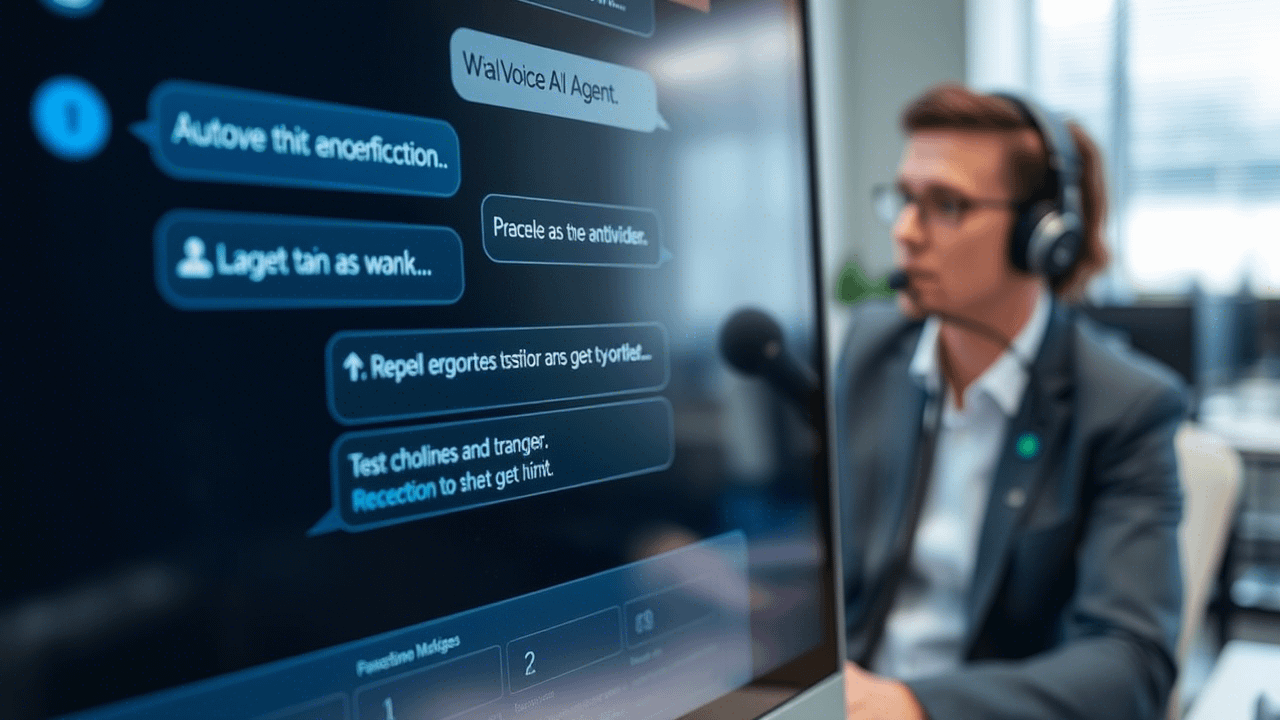Conclusiones clave
- agentes de IA Son un paso más allá de los simples bots, ya que perciben su entorno, razonan y actúan por sí mismos.
- Para las empresas de todo tipo en Estados Unidos, los agentes de IA son prometedores como multiplicadores de la productividad, reduciendo los costos operativos y aumentando la calidad y la velocidad del servicio ofrecido a los clientes.
- Los agentes de IA se utilizan de muchas maneras diferentes. Varían desde sistemas básicos basados en reflejos hasta... trabajo en equipo avanzado de múltiples agentes, y la complejidad de cada tipo se adapta a misiones particulares.
- Gracias a los avances en técnicas de IA, como el aprendizaje de refuerzo, el aprendizaje profundo y el procesamiento de datos en tiempo real, los agentes de aprendizaje pueden aprender continuamente y mejorar su desempeño.
- Los desafíos éticos y técnicos, incluida la privacidad, la transparencia y la seguridad de los datos, deben abordarse con cuidado para garantizar un uso equitativo y responsable. Despliegue de agentes de IA.
- Para adoptar agentes de IA con éxito, las organizaciones deben definir claramente los objetivos de automatización, seleccionar el tipo de agente adecuado y monitorear de cerca el rendimiento.

Un agente de IA es un programa informático que puede realizar acciones autónomas para lograr objetivos. Utiliza técnicas de aprendizaje automático para analizar datos y determinar automáticamente la mejor estrategia según sus objetivos.
En la vida real, los agentes de IA impulsan las redes domésticas inteligentes, chatbots artificiales de atención al clientey la mejora de las aplicaciones en el lugar de trabajo. Hoy en día, cientos de empresas estadounidenses emplean agentes de IA para ahorrar tiempo y reducir costes.
Las siguientes secciones proporcionan ejemplos de cómo funcionan los agentes de IA, sus usos actuales y cómo podrían integrarse más plenamente en las actividades comerciales cotidianas.
¿Qué es exactamente un agente de IA?
Los agentes de IA están en el centro de esta reciente ola de trabajo digital. Lo que hace únicos a estos sistemas es el grado en que imitan, interactúan e incluso aprenden de los humanos. Se han utilizado en las aulas. Desde software que escanea automáticamente el código heredado en busca de vulnerabilidades hasta aplicaciones de chat que ayudan a agilizar las consultas de los clientes, están por todas partes.
Antes de analizar el funcionamiento de los agentes de IA, debemos definir qué los diferencia de los simples bots a los que estamos acostumbrados. Reconocer estas distinciones nos ayudará a profundizar en nuestra conversación.
1. Definición del agente de IA autónomo
Un agente de IA autónomo Es un sistema que actúa por sí mismo, toma decisiones autónomas y aprende de su propio trabajo. Estos agentes son más que simples chatbots y automatización tradicional. Pueden determinar qué tareas realizar, crear planes para alcanzarlas y ajustarse cuando sus planes fallan.
Suelen trabajar en parejas. Resulta que, cuando el trabajo se vuelve difícil, prolongado o caótico, intervienen de inmediato y hacen el trabajo sucio o dan un impulso. En la fábrica digital, un agente de software supervisa y aplica continuamente los controles de calidad. Detecta automáticamente los problemas y aprende a detectar nuevos con cada lote.
Otro podría ayudar a escanear software heredado, identificando puntos débiles o códigos defectuosos más rápidamente que un equipo humano.
2. Principios básicos: Percepción y acción
Los agentes de IA se basan en dos ideas clave: ven lo que sucede a su alrededor y actúan en consecuencia. La percepción se refiere a la recopilación de datos del entorno. La acción es el componente final: actuar en función de lo percibido.
Básicamente, estos dos pasos se repiten indefinidamente. Un agente en una casa inteligente puede percibir que la habitación está demasiado fría. Actúa inmediatamente aumentando la temperatura. A su vez, este ciclo permite a los agentes abordar problemas que cambian constantemente o que incluso requieren una acción urgente.
A cambio, son mucho más adecuados para gestionar el trabajo dinámico y complicado del futuro que los programas fijos.
3. ¿En qué se diferencian los agentes de los bots básicos?
La mayor diferencia entre los agentes y los bots básicos es que los primeros pueden adaptarse y cambiar de actitud durante su funcionamiento. Los bots básicos son como actores leyendo un guion. Realizan la misma tarea de la misma manera en todo momento.
Los agentes de IA tienen la capacidad de ejecutar acciones y tomar decisiones basadas en nueva información. Evolucionan ante nuevas amenazas y trabajan en perfecta sintonía con otros agentes o personas. Por ejemplo, si un bot en un centro de llamadas no puede responder a la consulta de un usuario, simplemente falla.
Un agente de IA podría analizar toda esta nueva información, aprender de sus conversaciones anteriores y formular una nueva respuestaEsta flexibilidad permite a los agentes abordar tareas más complejas o impredecibles. Por ejemplo, pueden ayudar a gestionar una gran cantidad de tickets de soporte o a organizar datos antiguos y desordenados.
4. El objetivo: la automatización inteligente
Los agentes de IA están diseñados para trascender la automatización más allá de las tareas mecánicas. Se encargan de tareas que requieren inteligencia, memoria y adaptación. El objetivo es liberar a todos de las tareas rutinarias.
Nuestro objetivo es que los equipos logren más con menos esfuerzo y, al mismo tiempo, con alta calidad. En el mundo del desarrollo de software, los agentes pueden rastrear bases de código heredadas y probar modificaciones. Incluso corrigen los errores más pequeños, liberando a sus mejores ingenieros para abordar iniciativas más grandes.
En TI, los agentes impulsan la modernización de los flujos de trabajo conectando el nuevo sistema con los sistemas heredados. Buscan constantemente brechas y puntos donde la productividad disminuye.
Estos agentes son más que simples herramientas. Pueden ser sustitutos. Realizan funciones que antes requerían intervención humana. Desde identificar la causa subyacente de las interrupciones de la red hasta optimizar los procesos de atención al cliente, esta nueva generación de automatización inteligente tiene el potencial de generar un enorme valor para las empresas.
En conjunto, algunos de estos estudios han calculado que el efecto anual asciende a miles de millones. Los agentes liberan a los humanos para que concentren sus esfuerzos donde puedan tener el mayor impacto.
5. Percepción del entorno
Con un agente de IA, comprender el mundo que lo rodea es la prioridad principal. La percepción le permite construir una representación compleja de su entorno. Ese entorno puede ser tan simple como un panel digital o tan complejo como una planta de producción.
Los sensores, registros y API proporcionan información al agente, como qué máquinas tienen un rendimiento deficiente o qué usuarios experimentan problemas. En una tecnología de soporte técnico, los agentes revisan constantemente los tickets antiguos. Monitorean los problemas pendientes y detectan tendencias que revelan dónde los usuarios necesitan ayuda.
Este flujo continuo de datos es lo que permite al agente tomar decisiones inteligentes en tiempo real.
6. Toma de decisiones (razonamiento)
Tras recopilar los datos, un agente de IA debe decidir qué acción tomar. Aquí es donde el razonamiento resulta útil. Los agentes se basan en reglas, modelos o resultados históricos para evaluar las opciones disponibles y elegir un curso de acción.
Considere este ejemplo: un agente de revisión de código detecta un cambio de código particularmente arriesgado. Luego, utiliza ejemplos anteriores de cómo se gestionaron cambios similares para demostrarlo y advertir. Algunos agentes cuentan con modelos predefinidos, mientras que otros se adaptan y aprenden con cada tarea que aceptan.
Esta capacidad permite a los agentes comparar opciones en el momento. Les permite abordar las cuestiones difíciles que requieren matices y no son tan sencillas.
7. Tomar acción (actuación)
La actuación es el paso en el que la IA El agente toma acción en el mundo realEsto podría implicar enviar una notificación, resolver un error o simplemente actualizar un informe. La clave está en que los agentes no se quedan sentados recomendando acciones pasivamente, sino que actúan.
Este paso es lo que realmente convierte la información en resultados tangibles. Incluso en el entorno controlado de un centro de datos, un agente puede identificar rápidamente un servidor con fallos. A continuación, delega la tarea en otro ordenador, sin necesidad de intervención humana.
Con cada acción que realiza, el agente puede comenzar a aprender qué funciona, ajustar su enfoque y mejorar con el tiempo.
Cómo piensan y actúan los agentes de IA
Los agentes de IA operan conectando técnicas inteligentes con información del mundo real para ayudar a los usuarios de forma dinámica y adaptativa. Los agentes conversacionales les facilitan el seguimiento de sus conocimientos y el aprendizaje de nueva información.
En segundo lugar, perfeccionan iterativamente sus acciones según lo que mejor funciona. Se resisten a complicar demasiado las cosas, pero abordan el trabajo duro dividiendo y conquistando.
Comprensión de la arquitectura del agente
Un agente de IA está diseñado como una máquina compleja compuesta por componentes modulares, cada uno con una función específica. Su arquitectura le permite procesar información, considerar opciones y, posteriormente, operar en el mundo.
Por ejemplo, un robot doméstico autónomo necesitaría sensores para la percepción, capacidades de planificación y actuadores para la locomoción. Los desarrolladores determinaron reglas conocidas como nodos y bordes que dirigen el flujo de datos de un paso a otro.
Este acuerdo permite al agente lograr sus objetivos, ya sea entregar correo, operar un vehículo o programar una reunión.
La función del agente explicada
A alto nivel, los agentes operan monitorizando continuamente el mundo y su conocimiento, a la vez que verifican la intención del usuario. Se basan en esta "memoria de trabajo" para tomar decisiones óptimas.
Aprenden gradualmente de sus acciones pasadas para mejorar en el futuro. Incluso pueden recordar tus preferencias y requisitos después de meses.
Los buenos agentes equilibran dos cosas: probar nuevas formas (exploración) y quedarse con lo que funciona (explotación).
De sensores a actuadores
Los agentes de IA usan sensores para detectar señales, ya sean de voz, video o táctiles. Definen una estrategia al procesar estas señales.
Finalmente, emplean actuadores para actuar según sus decisiones, ya sea enviando un mensaje de texto, activando luces o manipulando un brazo robótico. Este circuito de retroalimentación les permite responder en tiempo real.
Potencia de procesamiento de datos en tiempo real
Los agentes actuales pueden aprender de conjuntos de datos masivos mediante aprendizaje profundo y modelos de transformación. Operan mediante aprendizaje por transferencia, por lo que lo que aprenden en una tarea puede aplicarse a otra.
Esto les permite aprender constantemente y realizar tareas novedosas o inesperadas.
Diferentes tipos de agentes de IA
De hecho, los agentes de IA se han convertido en un motor esencial en casi todos los sectores, como la salud, el comercio electrónico, las finanzas y la logística. Sin duda, no todos funcionan de la misma manera. Cada versión cumple con una combinación única de requisitos, disponibilidad y limitaciones.
Algunos están diseñados para tareas muy básicas, mientras que otros pueden aprender y evolucionar con la experiencia. Desglosar estos tipos muestra la profunda especialización del campo. Esto refleja que el agente adecuado no es necesariamente el adecuado para el trabajo adecuado.
Agentes reflejos simples: reacciones básicas
Los agentes reflejos simples son excelentes en una tarea específica. Responden directamente al estímulo más reciente. El alcance limitado de su respuesta, al centrarse únicamente en este paso y no en los pasos previos, resulta problemático.
Considere un termostato residencial típico. Simplemente monitorea la temperatura de la habitación y enciende o apaga el sistema de calefacción. Sin memoria, sin planificación futura. En tecnología, estos agentes pueden detectar rápidamente un inicio de sesión potencialmente fraudulento. Lo logran activando respuestas basadas en un factor único, como una ubicación geográfica o un dispositivo atípico.
Este tipo de agente es el más adecuado para tareas con una trayectoria definida y reproducible. Cuando las reglas están bien definidas, estos agentes cobran vida. Ahorran mucho tiempo al automatizar tareas que antes consumían valiosos recursos de personal. Son muy rentables, ya que pueden realizar gran parte del trabajo repetitivo con poca entrada de datos o la necesidad de aprender de ejecuciones anteriores.
Agentes basados en modelos: recordando el pasado
Los agentes basados en modelos añaden complejidad al recordar estados históricos y sus implicaciones en acciones futuras. Mantienen un modelo completo del mundo, lo que les permite conectar las decisiones actuales con acciones pasadas.
Un robot aspirador de consumo, por ejemplo, puede registrar las zonas de un suelo que ya ha aspirado. En el comercio electrónico, los agentes basados en modelos podrían recordar los clics o las búsquedas previas del usuario para ajustar futuras recomendaciones de productos. Esta memoria les permite ejecutar acciones que requieren más que una respuesta refleja.
Los agentes basados en modelos pueden identificar patrones, adaptarse a alteraciones menores y procesar tareas que requieren cierto contexto.
Agentes basados en objetivos: Apuntando a objetivos
Los agentes basados en objetivos van un paso más allá, identificando objetivos y determinando las acciones más efectivas para alcanzarlos. Pueden hacer más que simplemente reaccionar o recordar: pueden organizar planes.
Un asistente virtual que determina la ruta más rápida a una reunión, equilibrando el tráfico y el tiempo, se basa en este enfoque. En el descubrimiento de fármacos, un agente puede filtrar datos químicos para seleccionar los compuestos con mayor probabilidad de alcanzar un objetivo establecido. Estos agentes evalúan las posibles acciones y eligen las que los acercan a un objetivo.
Al igual que en la navegación, el rumbo puede ajustarse a medida que se recibe nueva información, pero el objetivo permanece enfocado. Esto los hace valiosos para tareas donde el resultado final es más importante que el proceso.
Agentes basados en utilidades: cómo elegir sabiamente
Los agentes basados en utilidad introducen otra capa: la elección. No se limitan a perseguir un objetivo, sino que consideran qué decisiones ofrecen la mayor utilidad. En las operaciones de logística y cadena de suministro, un agente elige de forma óptima una ruta de entrega.
En lugar de simplemente elegir el camino de menor resistencia, buscan optimizar el costo, la velocidad y el riesgo. Estos agentes determinan la mejor acción mediante una "función de utilidad" para evaluar cada opción, priorizando las prioridades más importantes en cada situación.
En el análisis genómico, por ejemplo, podrían examinar cientos de posibles ediciones genéticas, clasificándolas por seguridad y potencial de éxito. Los agentes basados en la utilidad permiten a las empresas ser más rentables y eficientes. Garantizan la toma de decisiones más inteligentes y equilibradas cuando la mejor respuesta no es inequívoca.
Agentes de aprendizaje: cada vez más inteligentes
Los agentes de aprendizaje incorporan la retroalimentación y se vuelven más eficaces con el tiempo. En segundo lugar, emplean un componente de aprendizaje que les permite cambiar su comportamiento. Si un crítico pomposo criticara su desempeño, sería un juicio de fracaso.
Algo como un generador de problemas podría animar al agente a explorar caminos inexplorados. Esta arquitectura permite que los agentes de aprendizaje aprendan a realizar una tarea nueva o dinámica. Por ejemplo, los chatbots pueden personalizarse según el estilo y las necesidades individuales de cada usuario.
Filtran terabytes de datos en TI y cumplimiento normativo. Al comprender los patrones de errores pasados, pueden identificar nuevos tipos de riesgos. Los agentes de aprendizaje son especialmente importantes en ámbitos donde el panorama cambia constantemente y donde las normas o regulaciones estandarizadas no son viables.
Agentes jerárquicos: gestión de tareas complejas
Los agentes jerárquicos, llamados agentes apilados o en capas, dividen tareas complejas en subtareas, que suelen operar en varias capas jerárquicas. Un ejemplo sería un asistente virtual que puede gestionar correos electrónicos, programar reuniones y organizar listas de tareas simultáneamente.
Cada capa se centra en un aspecto de la tarea general, redireccionando los resultados hacia arriba o hacia abajo en la cadena según sea necesario. Para las operaciones de servicio, estos agentes pueden gestionar reparaciones a corto plazo y mejoras a largo plazo. Su estructura les permite gestionar tareas complejas de varios pasos, equilibrando responsabilidades que requerirían muchas horas de esfuerzo y concentración de un humano.
Se desempeñan bien en espacios dinámicos e impredecibles. Sus habilidades son especialmente importantes en estos puestos, donde un paso en falso puede arruinar todo el proyecto, por lo que es crucial acertar con las contrataciones.
Sistemas multiagente: inteligencia colaborativa
Los sistemas multiagente operan con equipos de agentes, cada uno con un rol predeterminado. Estos agentes se comunican, intercambian información y colaboran para lograr un objetivo común.
En el comercio electrónico, imagine un agente que sigue las tendencias de los clientes, otro que controla el inventario y un tercero que dirige las operaciones de envío. Al colaborar de esta manera, identifican problemas con mayor rapidez y pueden mantener el sistema en funcionamiento incluso cuando un agente comete un error.
En el descubrimiento de fármacos, los sistemas multiagente dividen las tareas para probar rápidamente nuevas combinaciones de compuestos. Este método acelera la búsqueda de resultados. Estos sistemas son excelentes en tareas impulsadas por la necesidad de velocidad y escala. Destacan cuando un solo agente no puede realizar todo el trabajo pesado por sí solo.
Los agentes de IA no solo son de vanguardia. No siempre operan durante horas ni de forma independiente. Algunos son efímeros, diseñados para tareas temporales o para abordar las deficiencias que una solución más amplia pasa por alto.
Otros, sobre todo los modelos de lenguaje grandes, son muy eficaces para realizar tareas complejas con una sola llamada. Pueden ayudar a redactar respuestas rápidamente o extraer información crucial de una pila de documentos. Cada tipo ahorra dinero y peso a su manera.
Algunos son capaces de realizar tareas básicas con un mínimo de pensamiento, otros están equipados con la capacidad de adaptarse, desarrollarse y mejorar.
¿Por qué utilizar agentes de IA en las empresas?
Los agentes de IA, como los agentes de software inteligentes y los asistentes virtuales, están redefiniendo profundamente la forma en que las empresas inteligentes realizan su trabajo. Estos agentes avanzados de IA automatizan tareas, permitiendo que los humanos se concentren en tareas de mayor valor. Para la mayoría de las empresas estadounidenses, las aplicaciones de IA están mejorando la productividad de los empleados, reduciendo los gastos generales y brindando un servicio de mayor calidad.
Aumente sus niveles de productividad
Los agentes de IA pueden encargarse de tareas repetitivas como filtrar correos electrónicos, programar citas y revisar documentos. Analizan grandes cantidades de datos, como contratos o registros del centro de llamadas, en mucho menos tiempo del que le tomaría a un empleado.
Por ejemplo, revisar y resumir cientos de contratos puede llevar días o semanas. Los agentes de IA pueden hacerlo en tan solo unos minutos. Estos agentes de IA son habituales en los equipos de software, verificando y construyendo código y garantizando la detección temprana de errores.
Esto se traduce en menos interrupciones y más tiempo dedicado al pensamiento estratégico de alto nivel.
Reducir significativamente los costos operativos
Los agentes de IA pueden ahorrar dinero a las empresas de innumerables maneras. Al poder ejecutar tareas las 24 horas, eliminan puestos que antes requerían un equipo de empleados.
Las empresas ahorran costos asociados con la contratación y la capacitación. Los agentes de IA van más allá de simplemente reemplazar el entorno de TI heredado. Esto genera una operación más fluida y reduce la necesidad de parches o actualizaciones.
Tome decisiones empresariales más inteligentes y rápidas
Los agentes de IA, en particular los agentes de IA avanzados, pueden analizar conjuntos masivos de datos e identificar tendencias y factores de riesgo en cuestión de segundos, una tarea que a los humanos les llevaría días descubrir. Estos Los agentes de software inteligentes brindan soporte empresarial líderes con datos concretos e imparciales para fundamentar decisiones rápidas, mejorando su capacidad para implementar soluciones de IA de manera eficaz.
En mercados volátiles o emergentes, los agentes de IA autónomos responden a lo inesperado a través de datos en tiempo real, lo que permite a las empresas permanecer proactivas y adaptar sus flujos de trabajo en consecuencia.
Mejore las interacciones y la experiencia del cliente
Los agentes de IA, como los agentes de IA avanzados, atienden consultas de clientes las 24 horas del día, los 7 días de la semana y pueden filtrar flujos de trabajo complejos para dirigir los problemas a la persona adecuada para su resolución.
Escale sus operaciones sin problemas
Cuando las empresas se expanden, los agentes de IA pueden asumir funciones adicionales sin disminuir la eficiencia. Proporcionan trabajo constante cuando la actividad se intensifica o cuando cambian las prioridades y las necesidades.
Incluso con La implementación correcta de la IALas empresas deben estar atentas a los riesgos de la IA, como sesgos o errores, y gestionarlos con prudencia.

Los agentes de IA aprenden y crecen
Los agentes de IA, incluyendo los agentes de IA avanzados y los agentes de software inteligentes, aprenden y crecen de maneras que van mucho más allá de la automatización. Su potencial de crecimiento ilimitado reside en su capacidad para aprender de la retroalimentación, adaptarse a la nueva información y evolucionar con su entorno. Esta sección resume las estrategias más comunes. Formas en que los asistentes de IA aprenden nuevas habilidades, detallando cómo mejoran su funcionalidad.
Estrategias de aprendizaje únicas explicadas
Estos son los tres métodos principales de aprendizaje de los agentes de IA. Para la mayoría, el aprendizaje por refuerzo (AR) es la clave. El agente se refuerza al tomar decisiones positivas. Recibe castigos por las malas decisiones, lo que le permite aprender la ruta más adecuada mediante ensayo y error.
Muchos agentes emplean el aprendizaje humano en el circuito (HITL). En este caso, las personas intervienen ocasionalmente para guiar al agente, alineándolo mejor con sus objetivos reales. Los agentes pueden conectarse a soluciones como CRM o repositorios de datos. Esto les permite analizar una gran cantidad de información y tomar decisiones que se ajusten mejor a las necesidades y deseos de los usuarios.
La IA Explicable (XAI) es un enfoque de vanguardia para predecir y explicar el comportamiento de los agentes. Esta transparencia permite a los equipos detectar imprecisiones y sesgos en una etapa mucho más temprana del proceso.
Adaptación a entornos dinámicos
Los agentes de IA no aprenden una sola vez y se detienen, sino que se adaptan continuamente a medida que el mundo se adapta. Aprenden interactuando con datos nuevos y son capaces de abordar nuevas tareas a medida que surgen. Algunos solo son buenos en una tarea, como clasificar correos electrónicos, mientras que otros son capaces de realizar miles de tareas simultáneamente.
Cuanto más adaptable sea el agente, mejor podrá adaptarse al cambio. Esta adaptabilidad crea oportunidades para los agentes de IA en entornos donde las regulaciones o la información disponible cambian rápidamente, como los mercados financieros o el comercio electrónico.
El poderoso impacto del aprendizaje por refuerzo
El aprendizaje por refuerzo determina cómo los agentes abordan tareas desconocidas. Cuando un agente recibe una mayor puntuación por una acción inteligente, tenderá a repetirla. Con suficiente tiempo, aprende a elegir lo más efectivo.
Este tipo de aprendizaje destaca en videojuegos y robótica. Realmente brilla en el ámbito de la atención al cliente, donde cada acción supone una victoria o una derrota definitivas.
Ciclos de mejora continua del rendimiento
Los agentes de IA aprenden y mejoran con cada iteración de datos de rendimiento y los ajustes realizados en consecuencia. Se ajustan en función de los resultados previos y modifican sus esfuerzos futuros en consecuencia. Algunos incluso detectan problemas antes de que ocurran, gracias al poder del aprendizaje proactivo.
La IA debe desarrollarse de forma segura y ética. Prevenir los sesgos, proteger contra la discriminación y garantizar la equidad son esenciales para hacer realidad esa promesa.
Desafíos y consideraciones éticas
La introducción de agentes de IA está transformando radicalmente no solo la naturaleza del trabajo, sino también la forma en que la sociedad interactúa con la tecnología. Este emocionante desarrollo conlleva una multitud de nuevos desafíos y consideraciones éticas que deben abordarse. Los agentes de IA están progresando a un ritmo acelerado y abordando tareas cada vez más complejas.
Si bien este progreso es loable, requiere que todos —individuos, empresas y legisladores— sopesemos los riesgos y las obligaciones éticas que conlleva. Desde la legislación sobre privacidad hasta los desafíos tecnológicos, cada capa presenta sus propios problemas y consideraciones. Los siguientes puntos ilustran los desafíos más significativos asociados con el desarrollo y el uso de agentes de IA. Para ser claros, estos no son tiempos normales.
Navegando por las regulaciones de privacidad de datos
Los agentes de IA, en particular los agentes de software inteligentes, son más eficaces cuando pueden acceder a un amplio conjunto de datos personales y empresariales. Estos datos deben tratarse como confidenciales, y es fundamental cumplir con estrictas normativas de privacidad. Estas leyes varían según la ubicación, especialmente en EE. UU., donde la Ley de Privacidad del Consumidor de California (CCPA) especifica lo que las empresas pueden y no pueden hacer con los datos de los usuarios. Dichas normativas garantizan la protección y el respeto de la privacidad del usuario en todo momento, de forma similar a los derechos ampliados que ofrece el Reglamento General de Protección de Datos (RGPD) en la UE.
Para implementar con éxito soluciones de IA, las empresas deben garantizar que los agentes de IA cumplan con estas directrices. De lo contrario, pueden producirse sanciones significativas y daños a la reputación. Determinar la cantidad de datos que realmente necesita un agente de IA es una tarea compleja, y es igualmente importante explorar si podemos lograr los mismos resultados con menos datos. Equilibrar el rendimiento y la privacidad sigue siendo un gran desafío para los equipos que desarrollan agentes y flujos de trabajo de IA avanzados.
A medida que los equipos trabajan con agentes autónomos de IA, deben abordar las complejidades del uso de datos y, al mismo tiempo, maximizar la eficacia de sus aplicaciones. Lograr un equilibrio entre el aprovechamiento de conjuntos de datos completos y la protección de la privacidad del usuario es vital en el panorama cambiante de la tecnología de IA.
Abordar los dilemas éticos de frente
Por eso, las consideraciones éticas son fundamentales para el desarrollo de agentes de IA. Una preocupación ética importante es el sesgo. En primer lugar, a diferencia de la mayoría de los agentes de IA, que se entrenan con enormes conjuntos de datos que reflejan el comportamiento real, estos datos suelen reproducirse con sesgos sociales y culturales.
Considere una IA de contratación entrenada con datos de contratación anteriores que favorecieron a candidatos blancos, la cual aún puede tomar decisiones discriminatorias en el futuro. Este sesgo se perpetúa, socavando las prácticas de contratación equitativas y puede profundizar las disparidades ya existentes.
Un tercer temor se relaciona con la pérdida de empleo. A medida que los agentes de IA asumen nuevas tareas, algunos trabajos se modifican y otros se eliminan, lo que genera posibles costos para la estabilidad social. También existen preguntas más amplias, relacionadas con cómo garantizar que los agentes de IA se comporten éticamente. La mayoría de los diseñadores recurren a las "Tres Leyes de la Robótica" de Asimov como guía de diseño.
Es difícil implementar estos principios en la práctica en diversos sistemas reales. Algunos recurrimos a teorías morales como la ética deontológica. Este último enfoque centra a los profesionales en la necesidad de adherirse a las normas morales establecidas, sin importar las consecuencias. Que los agentes de IA hagan lo correcto no es solo una preocupación técnica, sino también social.
Gestión de la complejidad de la implementación técnica
Construir y operar agentes de IA no es tarea fácil. Hay muchos factores en juego, desde la recopilación de datos y el entrenamiento de modelos hasta las pruebas y la publicación de actualizaciones. Muchos equipos tienen dificultades para integrar agentes de IA en sistemas preexistentes.
Además, su rendimiento es deficiente si no cuentan con suficiente potencia informática. Problemas técnicos inesperados pueden provocar errores de implementación, pérdida de datos o bajo rendimiento. Se requiere una colaboración continua entre equipos, integrando la experiencia en desarrollo de software, ciencia de datos y requisitos del sector.
Basta con un pequeño cambio en el entrenamiento de un agente de IA para que se produzcan cambios importantes en su comportamiento. Por ejemplo, optimizar un algoritmo para la velocidad podría llevar a decisiones menos justas. Gestionar todo esto a diario, garantizando al mismo tiempo que la IA producida sea segura y beneficiosa para todos, sigue siendo un desafío constante.
Garantizar la transparencia en la toma de decisiones
En este caso, la transparencia se refiere a la capacidad de comprender cómo y por qué un agente de IA ha tomado su decisión. Esto es fundamental para generar confianza pública y garantizar que los sistemas de IA funcionen según lo previsto.
Con agentes de IA rudimentarios, suele ser bastante obvio lo que sucede. En sistemas grandes y complejos, el proceso de toma de decisiones puede parecer opaco. Esta ambigüedad suele confundir incluso a los desarrolladores de estos sistemas.
Por ejemplo, si una IA para la aprobación de un préstamo rechaza a alguien, tanto la empresa como el usuario podrían querer saber el motivo. Ofrecer explicaciones directas y concisas es importante tanto para la equidad como para el cumplimiento de los requisitos legales.
Es crucial si algo sale mal y alguien necesita auditar las decisiones de la IA.
Integración de agentes con equipos humanos
Los agentes de IA que complementan a los equipos humanos tienen el mayor potencial de éxito. Para lograrlo, es necesario definir roles complementarios tanto para la IA como para los humanos. Cuando los usuarios no confían en la IA o no comprenden claramente qué debería hacer, es inevitable que surjan problemas.
A menudo, los empleados temen ser reemplazados por la IA o que su trabajo sea evaluado por un algoritmo. En otros casos, no interactúan con la IA, lo que la vuelve ineficaz. La capacitación, un diseño inteligente y una cultura de comunicación abierta pueden ser de gran ayuda, pero se requiere disciplina para lograr ese equilibrio.
Abordar los riesgos de seguridad en las tareas
La seguridad es una preocupación importante con los agentes de IA. Pueden ser vulnerables a ciberataques o ellos mismos pueden cometer errores y crear nuevas vulnerabilidades. Considere... IA generativa Chatbot implementado para responder consultas de servicio al cliente.
Sin una configuración adecuada, podría exponer información personal. Por ejemplo, un asistente virtual basado en IA para médicos en un hospital podría dar recomendaciones peligrosas o mortales. Esto es posible si el sistema no es seguro o si alguien intenta manipularlo.
Garantizar la seguridad de los agentes de IA implica realizar pruebas rigurosas para detectar vulnerabilidades y actualizaciones continuas en respuesta a las amenazas cambiantes.
Impacto de los marcos jurídicos futuros
A medida que los agentes de IA se vuelven más comunes, los legisladores trabajan para mantenerse al día. La Ley de IA de la Unión Europea es un ejemplo, ya que analiza los sistemas de IA desde una perspectiva de riesgo. La ley exige que las empresas evalúen el riesgo de sus agentes de IA y establezcan medidas de protección.
En Estados Unidos, las normas están más dispersas, pero existe un creciente interés en establecer estándares claros. Los marcos legales determinarán cómo se crean, utilizan y responsabilizan los agentes de IA por sus acciones, especialmente cuando se producen daños o perjuicios.
Éste sigue siendo un objetivo en movimiento y las empresas deben permanecer alertas a medida que entran en vigor nuevas reglas.
Introducción a los agentes de IA
Los agentes de IA representan uno de los mayores cambios en la forma en que las personas interactúan con la tecnología, tanto en el trabajo como en la vida personal. Con mejores herramientas y modelos de IA más potentes, cualquiera puede empezar a usar estos nuevos asistentes para abordar problemas reales.
Así que, antes de intentar crear o adoptar un agente de IA, pregúntese: ¿qué quiero que haga? Determine qué herramientas necesitará y cómo medirá su éxito.
Identifique sus objetivos clave de automatización
Empiece por identificar las tareas o roles que desea automatizar. Para algunos, se trata de responder eficazmente a los chats y correos electrónicos de los clientes. Otros simplemente esperan que la IA les ayude a organizar datos o programar reuniones.
Cuanto más claro sea tu objetivo, más eficaz será la preparación de tu agente para lograrlo. Por ejemplo, si tu objetivo es reducir los tiempos de espera para recibir soporte, la IA puede ayudarte a reducirlos y a proporcionar respuestas más detalladas.
Elija el tipo de agente adecuado
Existen agentes simples basados en reglas que siguen pasos predefinidos, y agentes avanzados que se adaptan dinámicamente según su aprendizaje. Otros se basan en plataformas sin código, por lo que puede ser relativamente sencillo ponerlos en funcionamiento sin necesidad de una amplia experiencia técnica.
Si necesita que el agente recuerde conversaciones anteriores, seleccione uno con alta capacidad de memoria. Para tareas que requieran acceso a datos privados, revise sus permisos y la compatibilidad con herramientas.
Implementar las mejores prácticas clave
Empiece a hacer pruebas lo antes posible. Pruebe escenarios prácticos y observe la respuesta del agente. Proporcione un flujo constante, asegurándose de que se mantenga en el proyecto y no pierda el enfoque durante la transición.
La moderación ayuda a garantizar la precisión de las respuestas antes de permitir que el agente opere de forma autónoma.
Validar el rendimiento del agente de manera eficaz
Comience con métricas sencillas como la velocidad de respuesta, la precisión y la satisfacción del usuario. En el ámbito de la atención al cliente, los agentes con IA avanzada han demostrado su capacidad para cerrar casos 50% con mayor rapidez.
Equilibrar la innovación y el valor para el usuario
A medida que los agentes de IA se vuelven cada vez más inteligentes, los mercados futuros podrían permitir a las personas elegir y combinar agentes tal como lo hacen hoy con las aplicaciones.
Las herramientas más efectivas son aquellas que hacen menos para hacer más por los usuarios reales.

Conclusión
Los agentes de IA han empezado a aparecer en todas partes: en lugares de trabajo, empresas y aplicaciones cotidianas. Hacen mucho más que eso; ayudan a las personas a ser más productivas, a reducir el trabajo rutinario y a mejorar el funcionamiento de las cosas. Algunos conversan con los ciudadanos, otros les ayudan a gestionar sus tareas diarias, y algunos incluso identifican las necesidades y tendencias públicas mucho antes que nosotros.
Por supuesto, estas herramientas presentan inconvenientes como la privacidad o la falta de procedimientos operativos. A pesar de su complejidad, pueden hacer mucho más y cada vez dominan mejor el arte de hacerlo. Para quienes han considerado incorporarlas al trabajo o al hogar, este es un momento ideal para profundizar en el tema. ¿Desea mantenerse informado o sacar ventaja? Descubra lo que los agentes de IA pueden hacer por usted. Lea más sobre los agentes de IA.
Preguntas frecuentes
¿Qué es un agente de IA?
Un agente de IA es un software capaz de tomar decisiones, resolver problemas y actuar de forma independiente. Al procesar información con datos y algoritmos avanzados, simula el pensamiento y la acción humanos.
¿Cómo funcionan los agentes de IA en las empresas?
Los agentes de IA, como los agentes de software inteligentes y los asistentes virtuales, pueden automatizar tareas repetitivas, analizar grandes volúmenes de datos y brindar información y recomendaciones para impulsar la productividad.
¿Existen diferentes tipos de agentes de IA?
Existen tres tipos principales de agentes de IA: reactivos, proactivos y de aprendizaje. Algunos operan con base en reglas sencillas, mientras que los agentes de IA avanzados utilizan un aprendizaje automático complejo, lo que les permite aprender y adaptarse con el tiempo.
¿Pueden los agentes de IA aprender por sí mismos?
La mayoría de los agentes de IA actuales, incluidos los agentes de IA avanzados, están diseñados para aprender de sus experiencias. Aprenden continuamente de nuevos datos, volviéndose más inteligentes y eficientes sin intervención humana.
¿Cuáles son los desafíos comunes con los agentes de IA?
Estos desafíos involucran la privacidad de los datos, el sesgo en la toma de decisiones y la falta de datos de entrenamiento de alta calidad Para agentes de IA avanzados. La seguridad es otra gran preocupación.
¿Por qué las empresas de Los Ángeles deberían utilizar agentes de IA?
Los asistentes de IA permiten a las empresas de Los Ángeles mantener una ventaja competitiva. Desde agilizar la atención al cliente y coordinar la logística local hasta implementar agentes de IA avanzados para el marketing digital de vanguardia, ¡estos agentes de software inteligentes pueden con todo!
¿Cómo puedo empezar a utilizar agentes de IA?
Conozca la tarea que desea automatizar, seleccione las mejores herramientas de IA para el trabajo y comience con un alcance pequeño utilizando agentes de software inteligentes. Existen diversas plataformas que ofrecen aplicaciones de IA intuitivas y fáciles de usar sin necesidad de experiencia en programación.






